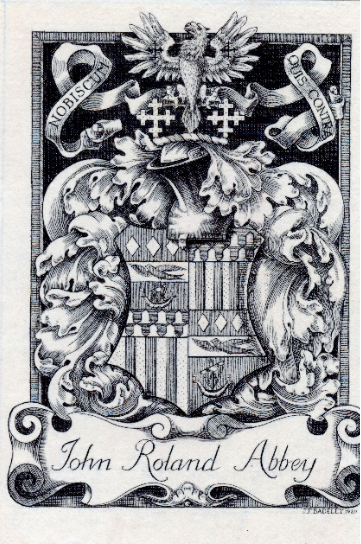Major J.R. Abbey 1894 - 1969

Editor’s Note: Fifty years ago, on Christmas Eve, this man, who was remarkable by the standards of even the most obsessive book collectors, died in the fullness of his years. The means to indulge his passion came from beer, the Kemp Town brewery in Brighton. What made his achievement extraordinary was that he was a dyslexic at the top end of the spectrum. In the best account of his life, by Christopher de Hamel, he is described as being ‘almost illiterate’. ‘He had virtually no grasp of capitalisation, spelling or punctuation. He knew no language but English. Nicolas Barker describes him bluntly as inarticulate,’ wrote de Hamel. Such then, was the man whose collecting is famed throughout the bibliographical world. Abbey spent most of his life in Sussex. To mark the anniversary of his death, Jeremy Knight, curator of the Horsham Museum & Art Gallery in that county, has assembled a small exhibition of Abbeyana in the museum. He writes:
While reading a back copy of The Book Collector for 1970, I saw in the obituary of Major Abbey that he’d been born at Sedgewick Park near Horsham. Not only that, but after living in Brighton, he’d moved to Greyfriars in Storrington. Horsham Museum has a remit to cover the 200 or so square miles of the District so Storrington, a small village lying under the Downs, was in our area of interest. Up to 1992 I’d been concentrating on building the Shelley Collection. Now I could add Jack Abbey to other noted ‘sons and daughters’ of the District, of which there are a surprising number.
There will be a number of books owned by him on display, in addition to the enlarged photographs of the bindings in the British Library. In the context of his dyslexia, the highlight will be a copy, one of 100, of a book ‘printed as a Christmas present for my friends 1952.’ In case the writing is unclear in the illustration, I reproduce the inscription here:
One Hundred Copies of this Book was printed As a Christmas present
for my friends 1952. It is partly a Reprint in the October Connossieur
with additional plates and catalogues.
J.R. Abbey Dec 1952
Our copy has his later bookplate, probably a Reynolds Stone design, the black oval with reversed-out calligraphic J R Abbey. Did all presentation copies of Silver Bindings from the Collection of J R
Abbey have this bookplate? It would perhaps make an intriguing quest to discover whether the choice of bookplate indicated the ranking of a friendship. Bought in 2009 from John Robertshaw for a few pounds, it is the most personal of his books we have on display.
That book illuminates his interest in bindings, as do the photographsfrom the British Library. However, as Christopher de Hamel pointed out, Abbey’s early interest was in fine printing and private press books. A book, of itself insignificant but gaining in importance for showing his interest in collecting not only the ‘trophy’ books of fine print but books just for their fine printing, is his copy of Arthur Symonds’s Parisian Nights, published by the Beaumont Press in 1926. It carries his grand armorial bookplate, which is almost the same size as the cover. This, along with other books owned by him, will be displayed in a small 17th century panelled room.
Those outside the book world will know next to nothing of Major Abbey, but part of the Museum’s remit is to remind people about past inhabitants of the district, whatever the nature of their fame. It’s why this year we featured our small Abbey collection alongside books borrowed from Parham House, literally his near neighbour, in a display on book collecting, and toured across the District a 2-metre high panel on Abbey in local bookshops and libraries.
The exhibition runs from 10 January to 28 March, 2020. The museum is open from 10 a.m. to 5 p.m. throughout the year and admission is free.
